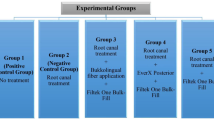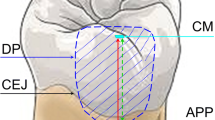Abstract
Objectives
Bulk-fill resin composites (BFCs) are gaining popularity in restorative dentistry due to the reduced chair time and ease of application. This study aimed to evaluate the influence of increment thickness on dentin bond strength and light transmission of different BFCs and a new discontinuous fiber-reinforced composite.
Materials and methods
One hundred eighty extracted sound human molars were prepared for a shear bond strength (SBS) test. The teeth were divided into four groups (n = 45) according to the resin composite used: regular particulate filler resin composite: (1) G-ænial Anterior [GA] (control); bulk-fill resin composites: (2) Tetric EvoCeram Bulk Fill [TEBF] and (3) SDR; and discontinuous fiber-reinforced composite: (4) everX Posterior [EXP]. Each group was subdivided according to increment thickness (2, 4, and 6 mm). The irradiance power through the material of all groups/subgroups was quantified (MARC® Resin Calibrator; BlueLight Analytics Inc.). Data were analyzed using two-way ANOVA followed by Tukey’s post hoc test.
Results
SBS and light irradiance decreased as the increment’s height increased (p < 0.05), regardless of the type of resin composite used. EXP presented the highest SBS in 2- and 4-mm-thick increments when compared to other composites, although the differences were not statistically significant (p > 0.05). Light irradiance mean values arranged in descending order were (p < 0.05) EXP, SDR, TEBF, and GA.
Conclusions
As increment thickness increased, the light transmission decreased for all tested resin composites. Discontinuous fiber-reinforced composite showed the highest value of curing light transmission, which was also seen in improved bonding strength to the underlying dentin surface.
Clinical relevance
Discontinuous fiber-reinforced composite can be applied safely in bulks of 4-mm increments same as other bulk-fill composites, although, in 2-mm thickness, the investigated composites showed better performance.


Similar content being viewed by others
References
Bowen RL (1962) Dental filling material comprising vinyl silane treated fused silica and a binder consisting of the reaction product of bis phenol and glycidyl acrylate. Patent No. US3066112 A
Leinfelder KF, Bayne SC, Swift EJ Jr (1999) Packable composites: overview and technical considerations. J Esthet Dent 11:234–249
Bayne SC, Thompson JY, Swift EJ Jr, Stamatiades P, Wilkerson M (1998) A characterization of first-generation flowable composites. J Am Dent Assoc 129:567–577
Chuang SF, Liu JK, Chao CC, Liao FP, Chen YH (2001) Effects of flowable composite lining and operator experience on microleakage and internal voids in class II composite restorations. J Prosthet Dent 85:177–183. doi:10.1067/mpr.2001.113780
Lee IB, Min SH, Kim SY, Ferracane J (2010) Slumping tendency and rheological properties of flowable composites. Dent Mater 26:443–448. doi:10.1016/j.dental.2010.01.003
Castaneda-Espinosa JC, Pereira RA, Cavalcanti AP, Mondelli RF (2007) Transmission of composite polymerization contraction force through a flowable composite and a resin-modified glass ionomer cement. J Appl Oral Sci 15:495–500
Tezvergil-Mutluay A, Vallittu PK (2014) Effects of fiber-reinforced composite bases on microleakage of composite restorations in proximal locations. Open Dent J 8:213–219. doi:10.2174/1874210601408010213
Garoushi S, Lassila LV, Tezvergil A, Vallittu PK (2006) Load bearing capacity of fibre-reinforced and particulate filler composite resin combination. J Dent 34:179–184. doi:10.1016/j.jdent.2005.05.010
Kovarik RE, Ergle JW (1993) Fracture toughness of posterior composite resins fabricated by incremental layering. J Prosthet Dent 69:557–560
Abbas G, Fleming GJ, Harrington E, Shortall AC, Burke FJ (2003) Cuspal movement and microleakage in premolar teeth restored with a packable composite cured in bulk or in increments. J Dent 31:437–444
El-Damanhoury H, Platt J (2014) Polymerization shrinkage stress kinetics and related properties of bulk-fill resin composites. Oper Dent 39:374–382. doi:10.2341/13-017-l
Truffier-Boutry D, Demoustier-Champagne S, Devaux J, Biebuyck JJ, Mestdagh M, Larbanois P, Leloup G (2006) A physico-chemical explanation of the post-polymerization shrinkage in dental resins. Dent Mater 22:405–412. doi:10.1016/j.dental.2005.04.030
Goncu Basaran E, Ayna E, Uctasli S, Vallittu PK, Lassila LV (2013) Load-bearing capacity of fiber reinforced fixed composite bridges. Acta Odontol Scand 71:65–71. doi:10.3109/00016357.2011.654240
Vallittu PK (2015) High-aspect ratio fillers: fiber-reinforced composites and their anisotropic properties. Dent Mater 31:1–7. doi:10.1016/j.dental.2014.07.009
Garoushi S, Vallittu PK, Watts DC, Lassila LV (2008) Polymerization shrinkage of experimental short glass fiber-reinforced composite with semi-inter penetrating polymer network matrix. Dent Mater 24:211–215. doi:10.1016/j.dental.2007.04.001
Sfondrini MF, Cacciafesta V, Scribante A (2011) Shear bond strength of fibre-reinforced composite nets using two different adhesive systems. Eur J Orthod 33:66–70. doi:10.1093/ejo/cjq030
Ilie N, Kessler A, Durner J (2013) Influence of various irradiation processes on the mechanical properties and polymerisation kinetics of bulk-fill resin based composites. J Dent 41:695–702. doi:10.1016/j.jdent.2013.05.008
Flury S, Peutzfeldt A, Lussi A (2014) Influence of increment thickness on microhardness and dentin bond strength of bulk fill resin composites. Dent Mater 30:1104–1112. doi:10.1016/j.dental.2014.07.001
De Munck J, Mine A, Poitevin A, Van Ende A, Cardoso MV, Van Landuyt KL, Peumans M, Van Meerbeek B (2012) Meta-analytical review of parameters involved in dentin bonding. J Dent Res 91:351–357. doi:10.1177/0022034511431251
Scherrer SS, Cesar PF, Swain MV (2010) Direct comparison of the bond strength results of the different test methods: a critical literature review. Dent Mater 26:e78–e93. doi:10.1016/j.dental.2009.12.002
Van Ende A, De Munck J, Van Landuyt KL, Poitevin A, Peumans M, Van Meerbeek B (2013) Bulk-filling of high C-factor posterior cavities: effect on adhesion to cavity-bottom dentin. Dent Mater 29:269–277. doi:10.1016/j.dental.2012.11.002
Bucuta S, Ilie N (2014) Light transmittance and micro-mechanical properties of bulk fill vs. conventional resin based composites. Clin Oral Investig 18:1991–2000. doi:10.1007/s00784-013-1177-y
Shortall AC (2005) How light source and product shade influence cure depth for a contemporary composite. J Oral Rehabil 32:906–911. doi:10.1111/j.1365-2842.2005.01523.x
Garoushi S, Vallittu P, Shinya A, Lassila L (2015) Influence of increment thickness on light transmission, degree of conversion and micro hardness of bulk fill composites. Odontology. doi:10.1007/s10266-015-0227-0
Lee YK (2008) Influence of filler on the difference between the transmitted and reflected colors of experimental resin composites. Dent Mater 24:1243–1247. doi:10.1016/j.dental.2008.01.014
(2013) Vivadent Ivoclar. Research and Development Report no. 19. Schaan Liechtenstein
Moszner N, Fischer UK, Ganster B, Liska R, Rheinberger V (2008) Benzoyl germanium derivatives as novel visible light photoinitiators for dental materials. Dent Mater 24:901–907. doi:10.1016/j.dental.2007.11.004
Garoushi S, Sailynoja E, Vallittu PK, Lassila L (2013) Physical properties and depth of cure of a new short fiber reinforced composite. Dent Mater 29:835–841. doi:10.1016/j.dental.2013.04.016
Le Bell AM, Tanner J, Lassila LV, Kangasniemi I, Vallittu PK (2003) Depth of light-initiated polymerization of glass fiber-reinforced composite in a simulated root canal. Int J Prosthodont 16:403–408
Uctasli S, Tezvergil A, Lassila LV, Vallittu PK (2005) The degree of conversion of fiber-reinforced composites polymerized using different light-curing sources. Dent Mater 21:469–475. doi:10.1016/j.dental.2004.08.001
SureFil® SDRTM Directions For Use. Dentsply 2011
Garoushi S, Vallittu PK, Lassila LV (2008) Depth of cure and surface microhardness of experimental short fiber-reinforced composite. Acta Odontol Scand 66:38–42. doi:10.1080/00016350801918377
Megremis S, Ong V, Lukic H and Shepelak H (2014) An ADA laboratory evaluation of light-emitting diode curing lights. http://www.ada.org/en/publications/ada-professional-product-review-ppr/archives/2014/november/an-ada-laboratory-evaluation-of-light-emitting-diode-curing-lights. Accessed 2015
Price RB, Ferracane JL, Shortall AC (2015) Light-curing units: a review of what We need to know. J Dent Res 94:1179–1186. doi:10.1177/0022034515594786
Price RB, Labrie D, Rueggeberg FA, Sullivan B, Kostylev I, Fahey J (2014) Correlation between the beam profile from a curing light and the microhardness of four resins. Dent Mater 30:1345–1357. doi:10.1016/j.dental.2014.10.001
Price RB, Rueggeberg FA, Labrie D, Felix CM (2010) Irradiance uniformity and distribution from dental light curing units. J Esthet Restor Dent 22:86–101. doi:10.1111/j.1708-8240.2010.00318.x
Michaud PL, Price RB, Labrie D, Rueggeberg FA, Sullivan B (2014) Localised irradiance distribution found in dental light curing units. J Dent 42:129–139. doi:10.1016/j.jdent.2013.11.014
Acknowledgments
This study belongs to the research activity of BioCity Turku Biomaterials Research Program (www.biomaterials.utu.fi).
Author information
Authors and Affiliations
Corresponding author
Ethics declarations
Conflict of interest
Author Tarek A. Omran declares that he has no conflict of interest. Author Sufyan Garoushi declares that he has no conflict of interest. Author Aous A. Abdulmajeed declares that he has no conflict of interest. Author Lippo V. Lassila declares that he has no conflict of interest. Author Pekka K. Vallittu declares that he consults Stick Tech—member of GC in training and RD.
Funding
This study belongs to and was supported by the research activity of BioCity Turku Biomaterials Research Program in Turku, Finland.
Ethical approval
This article does not contain any studies with human participants or animals performed by any of the authors.
Informed consent
For this type of study, formal consent is not required.
Rights and permissions
About this article
Cite this article
Omran, T.A., Garoushi, S., Abdulmajeed, A.A. et al. Influence of increment thickness on dentin bond strength and light transmission of composite base materials. Clin Oral Invest 21, 1717–1724 (2017). https://doi.org/10.1007/s00784-016-1953-6
Received:
Accepted:
Published:
Issue Date:
DOI: https://doi.org/10.1007/s00784-016-1953-6




